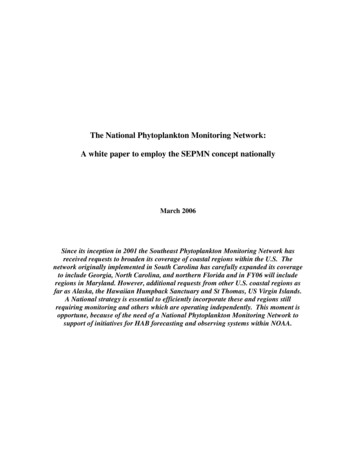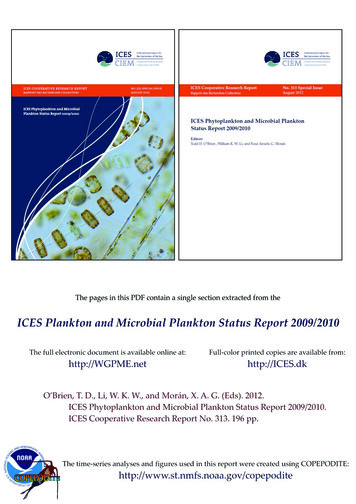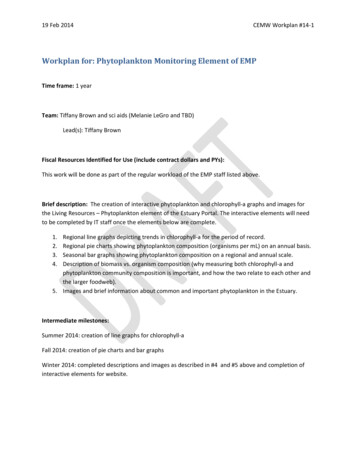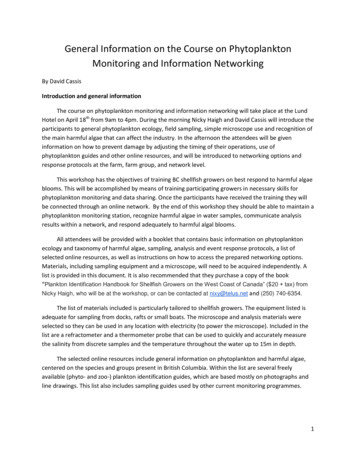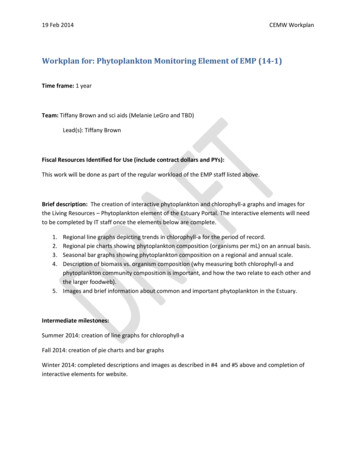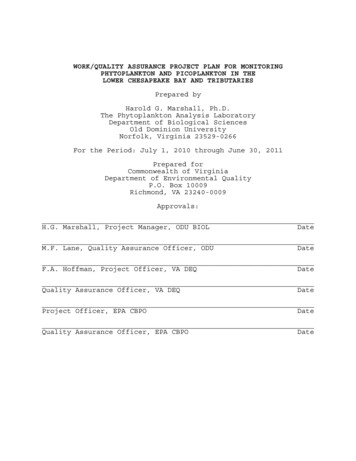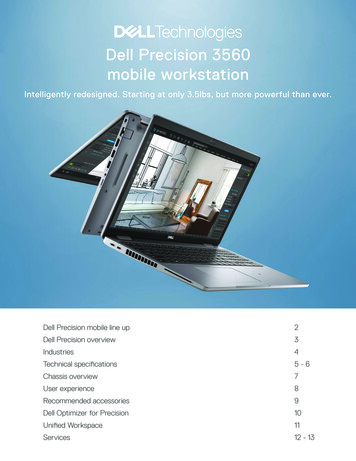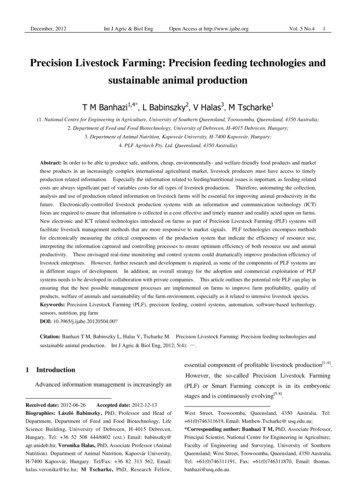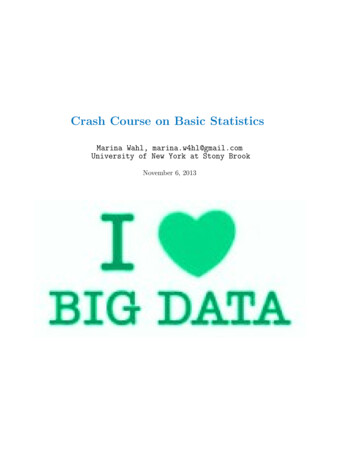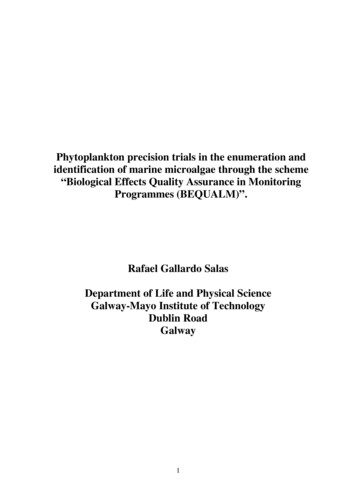
Transcription
Phytoplankton precision trials in the enumeration andidentification of marine microalgae through the scheme“Biological Effects Quality Assurance in MonitoringProgrammes (BEQUALM)”.Rafael Gallardo SalasDepartment of Life and Physical ScienceGalway-Mayo Institute of TechnologyDublin RoadGalway1
Acknowledgements.This study was carried out in the Marine Institute, phytoplankton unit in Rinville,Oranmore, Ireland between 2008 and 2010. I would like to thank the Marine Institutefor funding this research which has allowed me to present this work as a thesissubmitted for the award of research Masters in Science.I would like to thanks my supervisors Dr. David McGrath and Dr. Ian O’Connor,lecturers at the Galway-Mayo Institute of Technology Life Sciences Department fortheir help on the development of the structure and other aspects related to the Masters,for their support while being critical of the work and for reviewing the text andencouragement.Also, I would like to thank the staff at the Marine Institute phytoplankton unit forputting up with me through this period and for being supportive of this work.More thanks go to Mr. Joe Silke, section manager of the shellfish safety group in theMarine Institute for his support and critical assessment and review of the final text.My sincerest thanks go to Dr. John Newell, Head of the Biostatistics Department inBiomedical Sciences in NUIG for making statistics simple and accessible tounderstand for a biologist.His advice, time, patience, intelligence and wit haveallowed me through my numerous crises during this time to steady the boat and finishthis work.I would like to thank also Dr Jeremy and Dr Julianne Pickett-Heaps fromCytographics Ltd. in Australia for allowing me to use their wonderful qualityrecordings of algae for the identification intercomparison exercise in 2009. As abiologist, working with microscopes and images I appreciate very much theirgenerosity in providing these materials and the work and effort involved in producingsuch a high quality works.2
Thanks, also to CEFAS Technology Limited in the UK for administering andfacilitating the registration of participants to the BEQUALM scheme in the last twoyears.During this time, two workshops have been organised to present the data of theintercomparisons to the participants. One of the workshops took place in the MarineInstitute Headquarters in the auditorium, so I would like to thank the Marine Institutefor allowing me to use this facility. The second workshop happened in INTECMARin Vilaxoan, Galicia, Spain, so I would like to thank Yolanda Pazos Head of thephytoplankton unit and Covadonga Salgado Director of the centre for hosting thisworkshop in 2010.Also I wish to thank the invited guests at these workshops, the excellentphytoplankton taxonomists Dr. Urban Tillmann from AWI in Germany and SantiagoFraga from the IEO, in Spain for their excellent work and presentations at theworkshops.Finally, I would like to thank my family, my partner Fionnuala and children Iosac,Maeve and Blaithin for their love, warmth and friendship.3
4
AbstractScientists are coming under increased pressure in recent years to show that resultsthey obtain arising from their scientific work are quality assured and stand up toscrutiny by independent expert auditors. This has meant that the methodologies usedby laboratories involved in making these measurements have to be validated and fitfor purpose and has led to the adoption of internationally recognised standardprotocols.These protocols must be underpinned by robust quality systems and must beaccredited to an international standard. In order for laboratories to become accreditedin particular methods, they have to fulfil a series of prerequisites but a compulsoryone is the participation in a proficiency testing scheme.Proficiency testing schemes are independent assessor organisations which coordinateregular inter-calibration and intercomparative studies between laboratories with acommon purpose. What happens, though when proficiency testing schemes do notexist for a particular scientific measurement?This study presents results from two inter-comparison exercises at European levelbetween phytoplankton monitoring laboratories in the enumeration and identificationof marine microalgae using the Utermöhl cell counting method.Microalgae are a very important ecological component of the marine ecosystem andhave also become important ecological indicators of hydro-climatic change, oceanacidification and eutrophication. Member states of the European Union are obliged tomonitor for toxic and harmful algae which can cause problems and devastation in thenatural environment, have detrimental effects on human health if contaminated fishand shellfish are eaten, can cause huge economic losses to the aquaculture industryand impact directly in coastal communities.5
This study shows how an intercomparison of this kind is designed and organised, howsamples are set up, materials homogenised and reference values obtained. Itdemonstrates the importance of using the right technique and best practice, based onexperience, to analyse samples and how important it is to design the exercise to bestatistically robust, both quantitatively and qualitatively.The taxonomy quiz in 2009 showed that there was no evidence that video clips werebetter audit trail tools than images or vice versa. The quantitative measure suggestedthat there was evidence of good agreement between virtually all the analysts and thereference value for all species except one (P.micans). However, there was evidence oflack of reproducibility between and within laboratories. The qualitative measurecalculated indicated that analysts are more likely to identify a toxic organism as a nontoxic organism than the other way around.The results from the enumeration data in the 2010 exercise showed that there was lackof reproducibility across laboratories using different counting strategies and volumesub-sampled and analysed. These results when compared to a set of hypothesisedmeans used as reference values suggested that cell counts were potentiallyunderestimated by as much as 30% and that this underestimation was most likely dueto test method effects.6
Table of ContentsAbstractPages 5-6Table of contentsPages 7-10List of FiguresPages 11-13List of TablesPages 13-141. Introduction to proficiency testing in Phytoplankton monitoring programmes.Page 151.11.2 Proficiency testing schemes.Page 161.2.1 Quasimeme.Pages 16-171.2.2 Bequalm.Pages 17-201.3 Regulations and monitoring in the EU.Pages 20-211.4 Official methods for plankton analysis.Pages 21-231.5 Harmful algal blooms, their effect and the role of monitoring programmesPages 23-251.6 The National Monitoring Programme (NMP) for phytoplankton.Pages 25-271.7 Occurrence and detection of toxic algae: The Irish perspective.Pages 27-291.8 Economic and Social impacts of marine biotoxins.Pages 29-312. Bequalm 2009 Intercomparison exercise in the enumeration and identificationof PhytoplanktonPage 32AbstractPages 32-332.1 IntroductionPages 33-372.2 Materials and methodologiesPage 377
2.2.1 Phytoplankton samplesPage 382.2.1.1 Selecting culture materialsPage 382.2.1.2 Cell concentrationsPage 392.2.1.3 Sample types, treatments and replicatesPage 392.2.1.4 Sample preparation, homogenization and spikingPages 39-412.2.1.5 Sample randomizationPage 412.2.2 Taxonomic quizPage 422.2.2.1 Images and video footagePage 422.2.2.2 Technical aspectsPage 422.2.2.3 Quiz contentPage 422.2.3 Forms and instructionsPage 432.2.3.1 Couriers and materialsPage 432.2.3.2 InstructionsPage 432.2.4 Utermöhl cell counting methodPages 43-452.2.5 Statistical analysisPages 45-482.3 ResultsPage 492.3.1 ParticipantsPage 492.3.2 Phytoplankton quantification resultsPage 492.3.2.1 ‘Gold standard’ or reference valuePages 49-502.3.2.2 Reference data versus analysts dataPages 50-522.3.2.3 P.lima reference results versus P.lima analysts’ resultsPages 53-582.3.2.4 Prorocentrum micans cell counts variabilityPages 58-612.3.2.5 I-chartsPages 62-652.3.2.6 Z-scoresPages 65-672.3.2.7 Reproducibility within laboratoriesPages 68-718
2.3.2.8 Type D sample: negative controlPage 722.3.3 Phytoplankton identification resultsPages 72-752.3.4 Qualitative reliability measure resultsPages 75-782.4 Performance evaluationPages 78-792.5 DiscussionPages 79-833. Phytoplankton Intercomparison exercise Bequalm 2010 in the enumerationand identification of PhytoplanktonPage 84AbstractPages 84-853.1 IntroductionPages 85-873.2 Materials and methodsPage 873.2.1 Taxonomic quizPages 87-893.2.2 Phytoplankton samples: enumeration exercisePage 903.2.3 Forms and instructionsPage 913.2.3.1 Couriers and materialsPage 913.2.3.2 InstructionsPage 913.2.4 Statistical analysisPages 91-923.3 ResultsPage 923.3.1 ParticipantsPage 923.3.2 Phytoplankton identification resultsPages 93-1003.3.3 Phytoplankton enumeration resultsPages 100-1013.3.3.1 Learning effectsPages 101-1043.3.3.2 Method effectsPages 104-1103.3.3.3 Hypothesized meansPages 111-1143.3.3.4 Z-scoresPages 115-1163.4 Performance evaluationPage 1169
3.5 DiscussionPage 1173.5.1 Identification exercisePages 117-1193.5.2 Enumeration exercisePages 119-1214. General ConclusionsPages 121-1245. ReferencesPages 125-139Appendix 1: Instructions for phytoplankton exercise Bequalm 2009.Pages 140-146Appendix 2: Form 1 Return slip and checklist.Page 147Appendix 3: Form 3 Enumeration Hardcopy results.Page 148Appendix 4: Form 2: Taxonomic quiz.Pages 149-164Appendix 5: Statement of performance certificate.Pages 165-166Appendix 6: Reference values or ‘Gold Standard’.Page 167Appendix 7: Participating laboratories Bequalm exercise 2009.Page 168Appendix 8: Analysts Negative control sample (type d) results.Page 169Appendix 9: Identification results Taxonomic quiz images.Page 170Appendix 10: Identification results Taxonomic quiz video clips.Page 171Appendix 11: Instructions Intercomparison Bequalm PHY-ICN-10-MI1.Pages 172-180Appendix 12: Form 1 Checklist to Fax Bequalm PHY-ICN-10 MI1.Page 181Appendix 13: Form 2 Enumeration Hardcopy results.Page 182Appendix 14: Form 3: Taxonomic quiz.Pages 183-190Appendix 15: Correct answers to the identification test PHY-ICN-10-MI1.Pages 191-194Appendix 16: Statement of Performance certificate.Pages 195-196Appendix 17: Participating laboratories Bequalm 2010.Page 197Appendix 18: Hypothesised values based on Sedgewick-Rafter cell counts.Page 198Appendix 19: Analysts cell concentration counts Bequalm 2010.Page 199Appendix 20: Analysts methodologies Bequalm 2010.Page 20010
List of FiguresFigure 2.1: Concentration effects in samples Bequalm Intercomparison exercise 2008.Figure 2.2: Anderson-Darling Normality Test for Coscinodiscus granii cell countsFigure 2.3: Box plot of analysts versus reference cell counts for C.graniiFigure 2.4: Box plot of analysts versus reference cell counts for P.micansFigure 2.5: Box plot of analysts versus reference cell counts for Scrippsiella sp.Figure 2.6: Box plot of analysts versus reference cell counts for G.catenatumFigure 2.7: Box plot of analysts versus all reference cell counts for P.limaFigure 2.8: Main effects plot by sample type and analyst type for P.limaFigure 2.9: Standardized effects for factors and levels for P.limaFigure 2.10: Pareto chart of effects P.limaFigure 2.11: Main effects for P.micans cell counts across factors analyst & sample type.Figure 2.12: Normal plot of standardised effects for P.micans cell counts across factorsFigure 2.13: I chart of analysts observations for Prorocentrum micansFigure 2.14: I chart of analysts observations for Coscinodiscus graniiFigure 2.15: I chart of analysts observations for Scrippsiella trochoideaFigure 2.16: I chart of laboratory observations for Gymnodinium catenatumFigure 2.17: I chart of analysts observations for Prorocentrum limaFigure 2.18: Z-score for Coscinodiscus graniiFigure 2.19: Z-score for Gimnodinium catenatumFigure 2.20: Z-score for Scrippsiella sp.Figure 2.21: Z-score for P. micansFigure 2.22: Z-score for P.limaFigure 2.23: Scatter plot of analysts’ r, c and k from laboratory K against each otherFigure 2.24: Bias box plot of analysts’ r, c and k from laboratory K11
Figure 2.25: Box plot of analysts’ k, c and r from laboratory K versus reference value forG.catenatum.Figure 2.26: Analysts replicate cell counts by species. Sp1.I.b C.granii; Sp2.I.b G.catenatum; Sp3.II.b P.micans; Sp4.IIa S.trochoidea; Sp5.I.c P.lima.Figure 2.27: Mean measurements of species per laboratory Sp1.I.b C.granii; Sp2.I.b G.catenatum; Sp3.II.b P.micans; Sp4.IIa S.trochoidea; Sp5.I.c P.lima.Figure 2.28: Box plot of percent (%) correct images versus video clipsFigure 2.29: Case profile by laboratory of images versus videosFigure 2.30: Box plot of correct answers by setsFigure 3.1: Box plot of identification scores.Figure 3.2: Overall % correct answers by individual analysts.Figure 3.3: Main effect plot for identification scores by questions.Figure 3.4: Analysts learning effects box plots for Low cell density samples.Figure 3.5: Analysts learning effects box plots for High cell density samples.Figure 3.6: Individual values by analysts 1st count-2nd count at high concentration.Figure 3.7: Individual values by analysts 1st count-2nd count at low concentration.Figure 3.8: Box plot of 10ml, 25ml, and 2ml sub-samples at low concentrations againstcounting strategies.Figure 3.9: Individual value plot for low density samples.Figure 3.10: Box plot of Methods and counting strategies for high density samples.Figure 3.11: Residual plots of high density samples mean analysts results.Figure 3.12: Main effects plot of high density samples by method and by countingstrategy.Figure 3.13: Interaction plot of counting strategy, Method for high density samples.Figure 3.14: I chart of mean results (Low) by analysts and hypothesised mean.12
Figure 3.15: Individual plot (low) of 10ml and 25ml minus hypothesised mean.Figure 3.16: I chart of mean results (High) by analysts and hypothesised mean.Figure 3.17: Individual plot (high) by method and counting strategy minus hypothesisedmean.Figure 3.18: Individual value plot low biasFigure 3.19: Individual value plot high biasFigure 3.20: Box plot of Low versus High ZFigure 3.21: Z-score (Low) by laboratory codeFigure 3.22: Z-score (high) by laboratory codeList of TablesTable 2.1: Expression of reliability measure for identificationsTable 2.2: Paired T-Test and CI for P.lima: Analysts (type b) 1st vs. 2nd sampleTable 2.3: Two-Sample T for P.lima: Analysts type b mean vs. type c sample ( ve)Table 2.4: Paired T-Test and CI for P.lima: Reference (ref) versus Analysts ( ve) results.Table 2.5: Paired T-Test and CI for P.lima: Analysts type b mean vs. reference type b meanTable 2.6: General Linear Model for P.lima results: Cell count versus Analyst Type,Sample TypeTable 2.7: Paired T-test of analysts’ replicate P.micans cell counts type a samplesTable 2.8: Paired T-test of analysts’ replicate P.micans cell counts type b samplesTable 2.9: Two sample T-test of analysts P.micans cell counts for type a vs. type bsamples.Table 2.10: General Linear Model for P.micans cell counts across the factors analystand sample type with interactionTable 2.11: Descriptive statistics of identifications13
Table 2.12: General linear model for identification exerciseTable 2.13: Qualitative measurementsTable 3.1: Question 1 results identification exercise Bequalm 2010Table 3.2: Questions 2 and 3 results identification exercise Bequalm2010Table 3.3: Question 4 results identification exercise Bequalm 2010Table 3.4: Question 5 results identification exercise Bequalm 2010Table 3.5: Question 6, 7 & 8: Participants results intercomparison Bequalm 2010Table 3.6: Analysts overall score identification exerciseTable 3.7: Analysts overall rankTable 3.8: Descriptive statistics of identification results Bequalm 2010Table 3.9: Cumulative percentage of correct answersTable 3.10: Paired T-test of 1st and 2nd count of low cell density samplesTable 3.11: Paired T-test of 1st and 2nd count of high cell density samplesTable 3.12: Two sample T-test 10ml versus 25ml volumeTable 3.13: ANOVA statistics for high cell concentration samplesTable 3.14: General Linear Model of method and counting strategy for high densitysamples.14
1. Introduction to proficiency testing in relation to Phytoplanktonmonitoring programmes1.1 Introduction to intercalibration exercises and proficiency testing schemes.Intercalibration exercises across all disciplines of science are becoming importanttests to support and assure the quality of results. These results need to be backed up bya good quality system (Quality manual, 2001) where the traceability and confidence inthe results is important. Many difficult decisions in policy are made based onquantitative or qualitative measurements made by scientists. It is a good workingpractise that these results contain some indication of the quality of the results(EURACHEM/CITAC, 2000). Nowadays it is a requirement of laboratories to havequality assurance measures in place to provide data and measurements to a particularstandard.These measures include having a validated method in place, a series of internalquality controls, accreditation of the method, traceability of results and participationin proficiency testing schemes (ISO/IEC 17025, 1999).The tendency in marine science is to move towards the use of standardised methodsfor the measurement of diverse environmental, chemical and biological variables(AOAC, 1995). These methods are sometimes prescribed in European legislation asofficial methods and are recognised internationally as the standard method for aparticular measurement. ISO (International Standard Organisation) is the organisationdealing with providing the guidelines necessary to fulfil the quality requirements ofanalytical measurements.Accreditation means that the test method used for a particular measurement has beenvalidated and it is fit for purpose. A validation plan and report for the test method isfundamental towards providing a measure of the uncertainty of measurement for thetest method (Ellison et al., 1993) among other requirements.15
There are six basic principles of best analytical practise in analytical measurements.Intercomparison exercises alone fulfil two of these principles “There should be aregular independent assessment of the technical performance of a laboratory” and“Analytical measurements made in one location should be consistent with those madeelsewhere” (EURACHEM, 1998).This means that laboratories must participate in proficiency testing schemes and alsothat they must have internal quality controls in the form of intercalibration andintercomparative studies within and between laboratories.There are different types of interlaboratory comparison studies, from certificationtrials to method validation studies or collaborative trials to proficiency testing (PT)schemes. The latter are also known as External Quality Assessment (EQA) orLaboratory Performance (LP) studies.The present study focuses on PT schemes as in this type of interlaboratory studylaboratories can be assessed against other laboratories. It provides independentassessment of the quality of the routine analysis and provides comparativeinformation about method and instrument performance.1.2 Proficiency testing schemes1.2.1 QuasimemeIn 1992, the QUASIMEME (Quality Assurance of Information in MarineEnvironmental monitoring) was founded. This was the first Proficiency Testingscheme for analytical procedures measuring chemical and environmental parametersin marine ecosystems. This project was initiated with EU funding (1992-1996) andcontinued by subscription of the participating institutes afterwards.QUASIMEME was coordinated by the QUASIMEME Project Office at the FisheriesResearch Scotland (FRS) Marine Laboratory in Aberdeen, United Kingdom until2005. In 2005 the coordination was transferred to Wageningen University andResearch Centre (Alterra/WUR) in The Netherlands.16
The QUASIMEME Project Office operates under the guidelines provided in theISO/IEC 17043 for the development and operation of proficiency testing schemes andin the Guidelines for the Requirements for the Competence of Providers ofProficiency Testing Schemes (ILAC G13:08/2007).Some of the analysis that are carried out by QUASIMEME included nutrients inseawater, contaminants, metals, chlorinated organics, marine biotoxins, chlorophyll aamong others in a broad spectrum of chemical measurements. These routinelaboratory performance studies provided the basis of external quality assurance(EQA) for institutes that made regular chemical measurements in the marineenvironment.The output from these studies is reviewed annually by the QUASIMEME ScientificAssessment Group, which is comprised of experts in each of the main areas of theQUASIMEME Laboratory Performance (LP) studies.The QUASIMEME LP studies provide external quality assurance (QA) for nationaland/or international monitoring programmes, individual or collaborative research andfor contract studies. These studies support quality management and qualitymeasurement in the participating laboratories.Participants may use the assessment of the studied data to validate internal laboratoryQA, support accreditation, support QA of environmental monitoring data and providedata for national or international programmes.1.2.2 BequalmBequalm is a programme of biological measurements in the marine environment, thisprogramme includes a diverse array of measurements, from biomarkers to wholeorganism assays (fish disease, bioassay, luminescent bacteria), to community analysis(benthic community, Phytoplankton assemblage). The work in this thesis is based onthe work done only in the phytoplankton component of Bequalm that is the17
identification and enumeration of marine microalgae, which is part of the communityanalysis component of Bequalm.Marine biological measurements like the identification and quantification of marinemicroalgae through intercomparison exercises at a European level at least, had onlystarted in the year 2000 (Reckermann and M., Colijn, F., 2000), to the best of myknowledge. The development of this type of exercises is generally not as advanced asother marine analytical measurements. Some of the reasons for this is that analyticalmethods based on the measurement of the concentration of particular analytes inchemistry is done by modern instrumentation and equipment with given tolerances,specifications and sensitivities. In some cases certified reference materials (ISO/IEC33:1989) are available to provide reference values, standard curves and controls. Incontrast, biological methodologies like the identification and enumeration ofmicroalgae do not possess certified reference materials yet and the identification andenumeration of microalgae is done by the analysts not a piece of equipment, so thereis a certain subjectivity to the identification of species.The Biological Effects Quality Assurance in Monitoring Programmes (BEQUALM)project, funded by the European Union through the Standards, Measurements andTesting programme of the European Commission, was initiated in 1998(www.bequalm.org).This was in direct response to the requirements of the Oslo-Paris Commission(OSPAR) to establish a European infrastructure for biological effects qualityassurance and quality controls (QA/QC), in order that laboratories contributing tonational and international marine monitoring programmes can attain defined qualitystandards.Biological effects measurements are increasingly being incorporated into national andinternational environmental monitoring programmes to supplement chemicalmeasurements.The original project consisted of twelve work packages (WP) processed by ninepartner experts in measurements on biological effects and monitoring techniques, the18
phytoplankton component (WP 11) was entrusted to the Forschungs undTechnologiezentrum Westkuste (FTZ) at Kiel University, Germany. They carried outtwo interlaboratory comparison exercises or ring trials in 2000 and 2001 (Reckermannand M., Colijn, F., 2000, 2001). These were the first intercomparison exercises in theenumeration and identification of microalgae at European level.Some of the conclusions drawn from this first intercomparison were that theperformance on cell counting of the laboratories was of a high standard but that amore standardized protocol for cell counting was recommended. Also, there were ableto indicate that performances outside the confidence limits were exclusivelyassociated with analysts using low volumes (1ml aliquots) on Sedgwick-Rafter cellcounting chambers. They recommended not using these cell counting chambers orsimilar ones for counting phytoplankton field samples.A standardized protocol was used in the second intercomparison (2001) and thisappeared to improve the overall accuracy and precision of cell counting. Theconclusion was that standardized methodologies are required to improve the qualityand comparability of data at a European scale.After the 2001 ring trial, there were no more phytoplankton intercomparisons at thislevel from FTZ. In 2003 there was an attempt by INTECMAR in Galicia, Spain toorganise a phytoplankton ring trial worldwide. This intercomparison was set up in2003 under the name Iberia 2003 and the results were published in the proceedings ofthe IX Iberian meeting on toxin phytoplankton and biotoxins in 2007, Spain (Pazos etal., 2007).Also, in 2003, BEQUALM adopted the UK NMBAQC (National Marine BiologicalQuality Control Scheme) as a model to progress the Community Analysis componentwhich included Phytoplankton intercomparisons and launched the self-fundedprogramme (participants pay a fee) in 2004. The BEQUALM phytoplankton workpackage initially comprised two parts: chlorophyll analysis and community analysis.The former was taken forward by QUASIMEME, whilst from 2005, the latter ),throughBEQUALM/NMBAQC Scheme via the Marine Institute (MI) at Galway.19the
The MI phytoplankton unit under the BEQUALM/NMBAQC banner and with CTL(CEFAS Technology Limited) in the UK carrying out the administration andadvertising, organised the first phytoplankton intercomparison exercise in 2005 withcountries from Ireland and the UK initially. The MI has conducted a ,undertheauspicesofBEQUALM/NMBAQC annually since 2005.The purpose of these exercises are to compare the performance of laboratoriesengaged in national official/non-official phytoplankton monitoring programmes andother laboratories working in the area of phytoplankton, to test the methodologies thatare used for routine monitoring like the Utermöhl cell counting method (Utermöhl etal., 1931, 1958). Each intercomparison exercise in a given year is designed to test oneor various aspects of these methodologies.The participation in this type of scheme is becoming an essential requirement forNational phytoplankton monitoring laboratories in order to achieve accreditation fortheir methods. Since 2008, the participation of individual analysts on the scheme iscertified by issuing statement performance certificates to each participant.The Marine Institute phytoplankton laboratory is accredited to ISO 17025 for marinephytoplankton identification and enumeration since 2005, and it recognizes thatregular quality control assessments are crucial to ensure a high quality output ofphytoplankton data.The exercise has served as a forum for phytoplankton taxonomists to meet and debateon matters regarding marine phytoplankton but also as a way to intercalibrate resultsusing similar methodologies for the enumeration and identification of phytoplankton.1.3 Regulations and monitoring in the EUThe concern of European directives and official methods for plankton analysisregarding the placing of bivalve molluscs in the market for human consumption is theidentification and enumeration of toxin producing marine microalgae. As part of thenational reference laboratory for Biotoxins, the MI carries out statutory work to meet20
the EU requirements on bivalve molluscs through the hygiene directives 853/2004with regards to the placing of bivalves molluscs in the market for human consumptionand 854/2004 which lays the specific rules regarding the organisation of officialcontrols for monitoring and the specific directives dealing with the differentmethodologies used for chemistry and mouse bioassay testing (91/492/EEC,97/61/EC) of the different marine biotoxin groups. This entails the testing of shellfishchemically and through the mouse bioassay.The hygiene directive 854/2004 states that plankton must be monitored in shellfishharvesting in relaying areas. This directive supersedes a previous directive(91/492/EEC) and it states that plankton should be monitored periodically to be ableto detect changes in the composition of plankton containing marine biotoxins, alsoimportantly it says that plankton samples need to be representative of the watercolumn to be able to notice changes in population dynamics of toxin producingspecies. This latter point is a new addition to the 854/2004 EU directive.1.4 Official methods for plankton analysisWhile there are standardized official methods coming from the regulatory bodies inEurope regarding the testing of shellfish chemically and through the Mouse Bioassay,there are no official methods for the identification and quantification of plankton insamples.It is up to the different phytoplankton monitoring programmes, to decide on amethod/s that best equip them to identify the plankton species, found in theirterritorial coastal waters.The MI phytoplankton monitoring programme, uses the Utermöhl cell countingmethod for phytoplankton analysis. This method is a light microscopy based method,where samples are preserved and settled in sedimentation chambers over time, beforeanalysis is carried out.This m
2.2.1.2 Cell concentrations Page 39 2.2.1.3 Sample types, treatments and replicates Page 39 . 2.2.4 Utermöhl cell counting method Pages 43-45 2.2.5 Statistical analysis Pages 45-48 . Appendix 18: Hypothesised values based on Sedgewick-Rafter cell counts. Page 198 Appendix 19: Analysts cell concentration counts Bequalm 2010. Page 199


